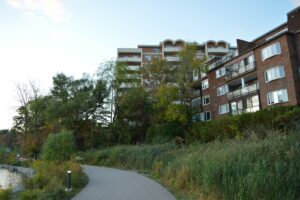Mike Henderson, Director of Regenerative Cities at consulting engineering firm Ramboll, assesses the government’s new Environmental Improvement Plan (EIP) and explores what is required to fulfill environment targets and ambitions.
Back in 2009 Natural England published ‘An estimate of the value and cost effectiveness of the expanded Walking the Way to Health Initiative scheme’, suggesting an annual saving of £2.1bn to the NHS if everyone had (or was perceived to have) good access to green space. This validated all those working on urban greening who had recognised for a long time the multitude of benefits that green spaces bring to our towns and cities.
Over the subsequent 14 years, there has been a plethora of studies showing the physical, mental, social, ecological and ultimately economic benefits of urban greening. So, while the new Environmental Improvement Plan’s (EIP) ‘new and ambitious commitment that everyone should live within 15 minutes’ walk of a green or blue space’ will undoubtedly be welcomed, it is not without dismay that it has taken quite so long to embed this in policy.
Green spaces must be high-quality, not just accessible
While this is an ambitious target, ambitious action seems somewhat lacking. Around 84% of people in the UK live in urban areas, yet the EIP seeks only to ‘create or significantly refurbish’ 100 parks through the Levelling Up Parks Fund. Given there are over 27,000 public parks and green spaces across the UK, this is a tiny number to focus on.
Many of these existing parks play hugely important roles for communities and nature, but without doubt, are increasingly becoming degraded and potentially dangerous. The quality of green spaces is as important, if not more so, than their proximity in attracting regular users. For instance, a report by The Guardian estimates that local authorities are spending £330m less per annum over the last 10 years on parks and green space – that is a drop 85 times greater than the one-off £39m commitment of the Levelling Up Parks Fund.
To be meaningful, we need a much greater and more strategic investment into maintaining and managing our green spaces. This should be delivered alongside an holistic approach to place-making and public realm. Some 80% of our public open spaces are roads. Creating more walkable and cyclable neighbourhoods that provide access to all the services one might require within 15 minutes of their front door, coupled with better public transit and provision of short term on-street car rentals in the ‘zip-car’ model, can drastically reduce the number of cars – particularly parked ones – from our streetscape. That freed space can then be used to create networks of green spaces with health and well-being, water management, urban cooling and air quality improvements, while also building better ecological connectivity throughout our urban environments.
However, the only way we are going to get this much-needed investment into our parks and urban green spaces is to properly value them for the services they provide, and bring the beneficiary stakeholders to the table.
The water management headache
Creating space within our urban environments is also important for effectively tackling one of the other ambitions of the EIP: clean and plentiful water. While there are welcome commitments to reduce agricultural run-off and restore the ecological status of 75% of water bodies, there is weak language to only ‘encourage’ water companies to reduce their pollution. Their approach to water cycle management remains distinctly linear – upstream extraction, carried over long distances, used/polluted, treated and released downstream for our rivers to do the final stages of cleaning.
There were some 400,000 untreated discharges, lasting over 300 hours, into our rivers in 2020; that is untreated human waste direct into our waterways. This occurs, in the most part, because the capacity of our sewer systems is increasingly unable to facilitate the level of effluent combined with surface water from storms that they are expected to take. This is only going to get worse as our urban areas become denser and rainfall becomes heavier with climate change.
One of the most effective ways of solving this is to take some of the water out of the equation by slowing its flow into the sewers and through reuse. Creating more urban green spaces is one way of enabling increased attenuation. New developments, however, could become increasingly circular in water management, not only capturing and slowing rainwater, but actively reusing it. Going further, there are a number of technologies on the market, such as the Organica greenhouse waste water treatment plants, that allow for grey and even black water (effluent) to be treated and reused locally.
However, despite water being a regulated market, there appears to be little appetite for challenges to the status quo of wasteful and polluting linear water management, predominantly overseen by highly profitable overseas companies. We need the regulator to help safely disrupt the sector to enable decentralised and circular approaches to water and storm water management.
Sustainable urban rural relationships
While unlikely to be within 15 minutes’ walk for many, the EIP does highlight the importance of improving access to the countryside as a way for more people to experience the health and wellbeing benefits of the ‘natural’ environment. The countryside is, however, far from natural, and dense urban areas and intensive rural agriculture are two sides of the same coin.
Urbanisation fundamentally changed rural land use to focus on food production in ways that are increasingly ecologically and economically unsustainable. In acknowledging the value created by our cities, we need to also acknowledge their costs to the function of natural ecosystems and the important services these ecosystems provide for our countryside. If we do not, their failure will ultimately undermine the success of our urban areas.
Creating more sustainable cities cannot therefore be separated from creating more regenerative rural areas – creating habitats to help replenish clean water and air, manage the impacts of climate change and provide space for wellbeing. However, much of the burden in improving land management is currently placed heavily on the shoulders of farmers without adequate funding support. For instance, the EIP needs to clarify how exactly it will incentivise farmers to ‘support a transformation in the management of 70% of our countryside’.
While the recent update to the Government’s Environmental Land Management (ELM) scheme goes some way in addressing the support needed to help farmers develop ecological techniques, we need more investment in nature-friendly approaches to agriculture which also considers human needs. After all, delivering environmental benefits through rewilding and more regenerative agriculture must be coupled with tangible benefits for people, and whilst the ELM is a start, it doesn’t go far enough.
Looking ahead
From access to green spaces, to water management, to ecological farming techniques, there are complex trade-offs to be made between social, environmental and economic principles. We can no longer see rural and urban environments as polarising forces and major questions remain about how we can tackle our changing relationships with nature and source the funding required to meet our commitments. It is promising to see we lack no ambition to improve our environment for the benefit for all, but holistic thinking must be matched with strategic investment to make it a reality.
Photos by Karim Sakhibgareev and Luiza Giannelli















